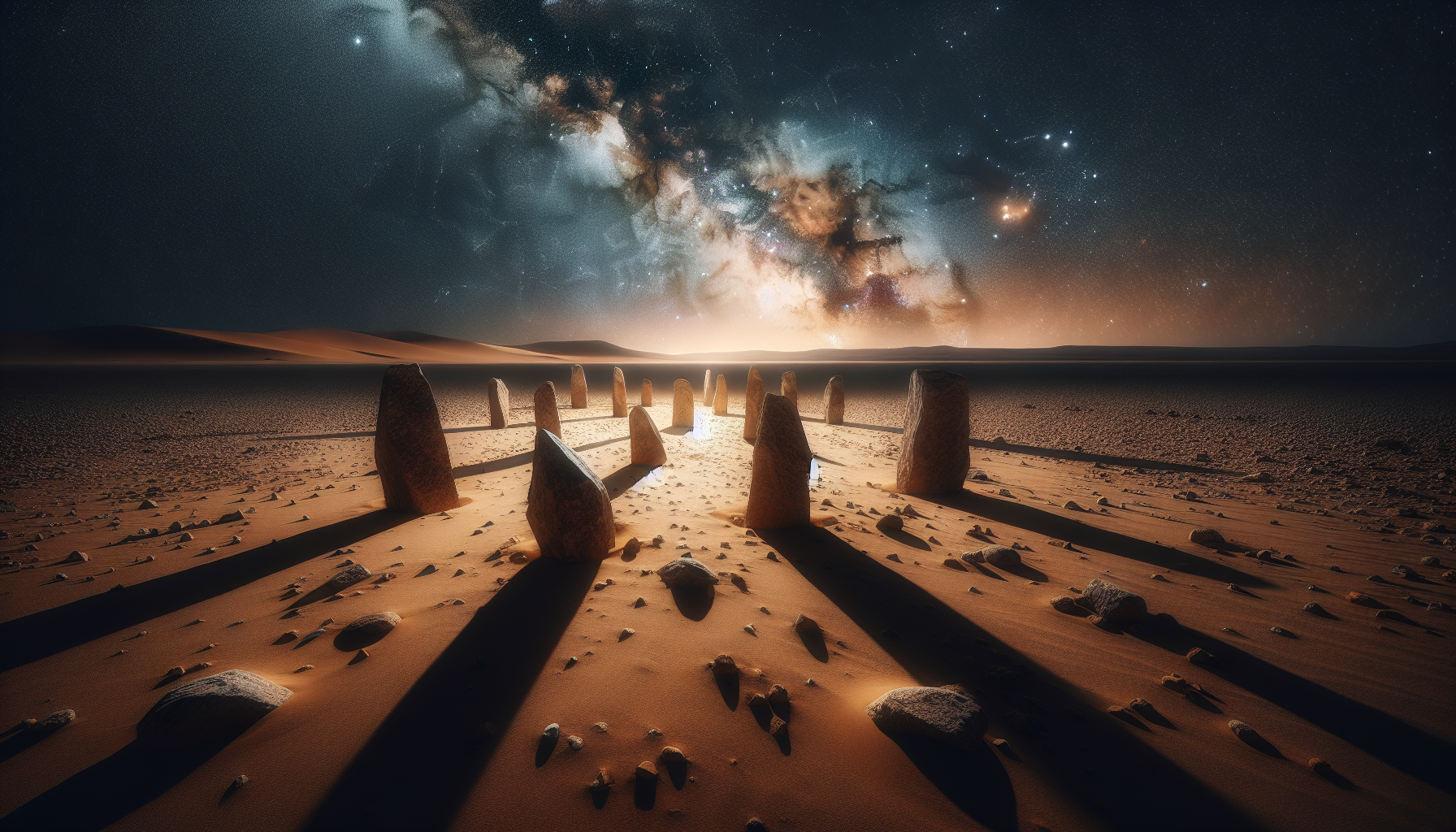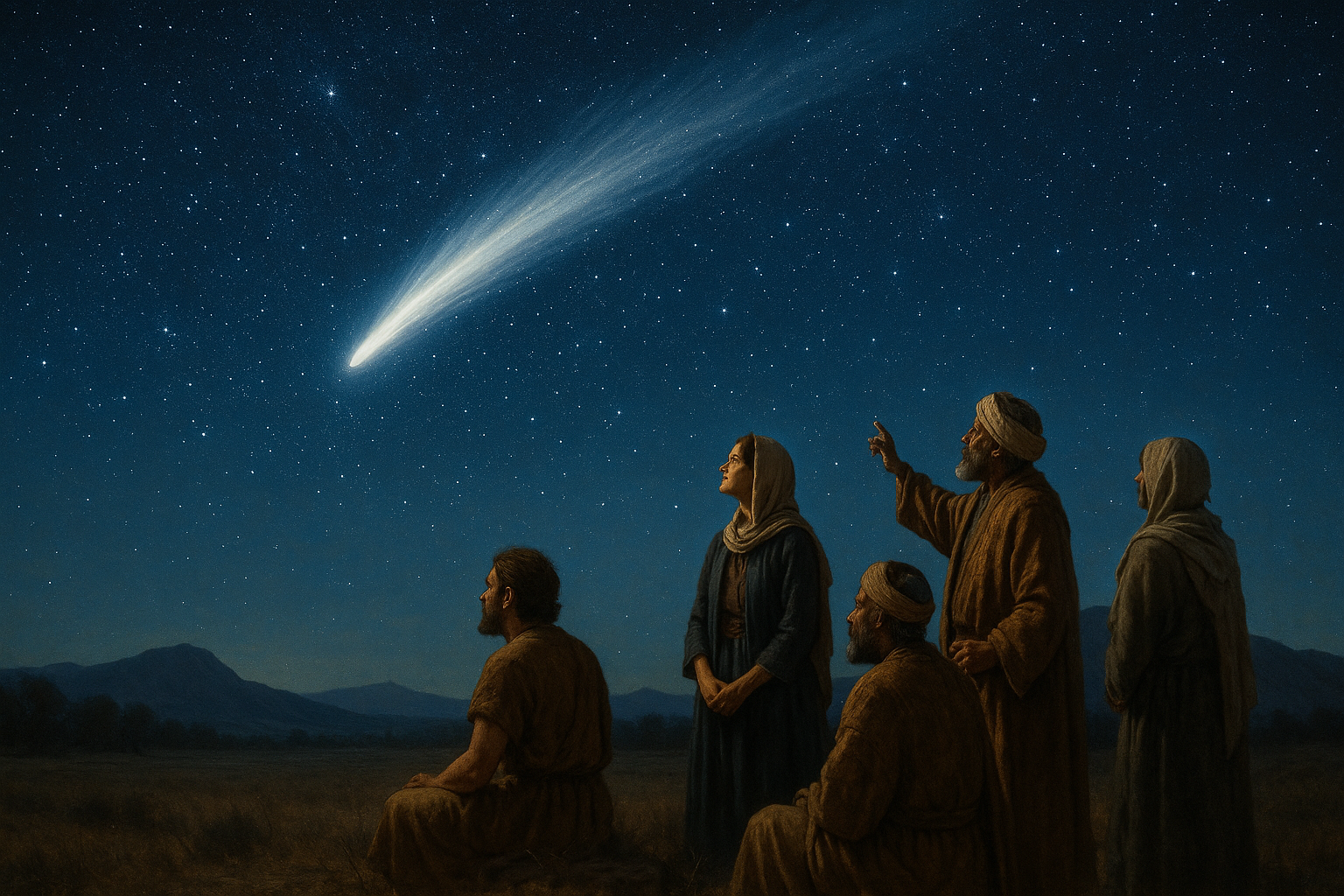In the vast expanse of the Sahara Desert, where the undulating dunes stretch endlessly towards the horizon and the scorching sun casts an eternal glow, lies a site shrouded in mystery and wonder. This ancient place, known as Nabta Playa, is not just an ordinary archaeological site; it is a celestial enigma that continues to captivate the minds of scientists, historians, and curious souls around the globe. As the golden sands whisper tales of bygone eras, Nabta Playa beckons us to delve deeper into its secrets, inviting us on a journey through time to uncover the remarkable legacy of its celestial markers. 🌟
Nabta Playa, located in southern Egypt, is often referred to as the “Stonehenge of the Sahara,” yet it holds unique mysteries distinct from its European counterpart. This archaeological site, dating back over 7,000 years, is a testament to the advanced understanding of astronomy possessed by its ancient inhabitants. Here, the stones stand as silent sentinels, aligned with precision to mark significant celestial events such as solstices and equinoxes. But what drove these ancient peoples to dedicate such effort to observing the heavens? What stories do these stones tell, and how did they shape the cultural and spiritual life of those who erected them? These questions form the crux of our exploration.
As we embark on this intellectual expedition, we’ll delve into the origins and significance of Nabta Playa, examining the remarkable achievements of the prehistoric people who transformed this remote desert basin into a bustling hub of human activity. Our journey will guide us through the intricate alignments of the stone circles, revealing how they served not merely as astronomical observatories but also as gathering places for rituals and social interactions. We’ll unravel the ingenuity behind the construction of these structures, pondering the motivations and beliefs that fueled their creators. Along the way, we’ll consider how Nabta Playa’s celestial markers continue to challenge our understanding of ancient civilizations and their connection to the cosmos.
Moreover, our exploration will extend beyond the stones themselves, as we consider the broader implications of Nabta Playa’s celestial alignments on our perception of prehistoric societies. How did these ancient communities view their place in the universe? What role did astronomy play in shaping their worldview and guiding their survival in a harsh environment? We’ll seek to understand the cultural and spiritual dimensions of Nabta Playa, piecing together the fragments of history to construct a vivid tapestry of human ingenuity and curiosity. Through the lens of modern science and historical research, we aim to illuminate the sophisticated understanding of the cosmos that thrived in this seemingly desolate landscape.
Join us on this captivating journey as we unveil the mysteries of Nabta Playa, traversing the sands of time to unravel the secrets of its celestial markers. From the intricate stone alignments to the cultural significance embedded within their placements, we invite you to step into the world of ancient astronomers and visionaries. Together, we’ll explore the enduring legacy of Nabta Playa, a testament to the boundless curiosity and creativity of humanity. As we stand amidst the remnants of this extraordinary site, we are reminded of the eternal quest to understand our universe—a quest that transcends time, cultures, and civilizations. 🌌
The Enigma of Nabta Playa
Deep in the heart of the Nubian Desert, situated in southern Egypt, lies Nabta Playa, an archaeological site of profound historical and astronomical significance. This site, often overshadowed by its more famous counterpart, Stonehenge, serves as a testament to the advanced understanding of astronomy by prehistoric peoples. Nabta Playa is a complex of stone circles, alignments, and structures believed to have been used for both ceremonial and astronomical purposes. This mysterious location invites curiosity, as researchers attempt to piece together the lives and knowledge of the peoples who once thrived in this now barren landscape.
The Nabta Playa site dates back to between 7500 BC and 4500 BC, a time when the climate of the Sahara was significantly different from today. During this period, the region experienced much wetter conditions, supporting a variety of flora and fauna that are now absent. This climatic change made the area a hospitable environment for human settlement and activity. The inhabitants of Nabta Playa were predominantly pastoralists, evidenced by the remains of cattle found in the region. They developed a sophisticated understanding of their environment, which extended to the celestial bodies above.
One of the most compelling aspects of Nabta Playa is its use as a primitive astronomical observatory. The alignment of the stone structures suggests that the inhabitants had a keen interest in celestial events, particularly the summer solstice. The configuration of the stones is believed to mark the position of the sun during this period, indicating an advanced comprehension of astronomical cycles and their significance for agricultural and ceremonial purposes. Such alignments also suggest that the site could have been used as a calendar to track the passage of time and seasons, which was crucial for survival in the arid climate.
The Celestial Alignments of Nabta Playa
The celestial alignments at Nabta Playa have been a subject of intrigue and extensive study. The precision with which the stone structures align with the solstices and other astronomical phenomena points to a level of sophistication that rivals that of other ancient observatories. For instance, the megalithic structures align with the cardinal points and have been interpreted as marking the midsummer solstice, much like Stonehenge in England.
The Nabta Playa stone circle, though less grand in scale compared to Stonehenge, shares a similar function. The stones are arranged in a way that aligns with the sunrise of the midsummer solstice, suggesting a symbolic or religious importance. Additionally, other stone alignments seem to point towards important stars and constellations, indicating that the ancient inhabitants had mapped out the night sky with considerable accuracy. The presence of these alignments underscores the importance of celestial events to the people of Nabta Playa, potentially influencing their cultural and spiritual practices.
Despite its age, Nabta Playa continues to offer insights into the early development of astronomy. Its significance lies not only in its physical structures but also in the way it reflects the cognitive abilities and cultural priorities of its builders. The site challenges modern perceptions of prehistoric societies, revealing a complexity and sophistication that demands further exploration and understanding. As research continues, the mysteries of Nabta Playa may yet unveil further secrets about humanity’s earliest astronomical endeavors.
Archaeological Discoveries at Nabta Playa
The archaeological explorations of Nabta Playa have uncovered a wealth of artifacts and structures that provide a window into the past lives of its inhabitants. Among these discoveries are a series of stone structures, tumuli, and human burials that shed light on the social and cultural practices of the time. The presence of cattle burials at the site is particularly significant, as it suggests a form of cattle cult or reverence, predating similar practices in ancient Egypt.
The tumuli, or burial mounds, found at Nabta Playa indicate complex social structures and possibly hierarchical societies. The burials, often accompanied by grave goods, suggest rituals and beliefs about life and death. These findings have led researchers to theorize about the social dynamics and religious practices of the people who inhabited Nabta Playa. The presence of pottery and other artifacts also hints at trade and interaction with other contemporary cultures, suggesting a network of communication and exchange.
These archaeological findings are crucial for understanding the broader cultural context of Nabta Playa and its significance within the prehistoric world. The site not only serves as a testament to the ingenuity of its builders but also as a key to unraveling the mysteries of early human civilization and its relationship with the cosmos.
Comparative Analysis: Nabta Playa vs. Stonehenge
| Aspect | Nabta Playa | Stonehenge |
|---|---|---|
| Location | Nubian Desert, Egypt | Salisbury Plain, England |
| Primary Function | Astronomical observatory and ceremonial site | Astronomical observatory and burial site |
| Time Period | 7500 BC – 4500 BC | 3100 BC – 1600 BC |
| Stone Structure | Stone circles and alignments | Megalithic stones and circles |
Check out the table above for a comparative analysis of Nabta Playa and Stonehenge, highlighting their similarities and differences in terms of location, function, time period, and structure.
Theories and Interpretations
Various theories have been proposed to explain the purpose and function of Nabta Playa. Some researchers suggest that the site served as a ceremonial center for prehistoric peoples, possibly linked to rituals associated with cattle and the solstices. The alignment of the stones with astronomical events further supports the idea of Nabta Playa being a center for celestial observation and timekeeping.
Another theory posits that Nabta Playa was a site of pilgrimage or gathering, where different groups came together to engage in shared rituals and exchange goods and ideas. This would have facilitated the spread of knowledge and cultural practices across regions, contributing to the development of more complex societies. The presence of artifacts from distant regions supports this idea, indicating a network of interaction and trade.
Despite the advancements in understanding Nabta Playa, many aspects of the site remain shrouded in mystery. As researchers continue to explore and analyze the site, new discoveries may provide further insights into the lives and beliefs of the ancient peoples who once inhabited this remarkable location. Watch the video below for more information on the astronomical significance of Nabta Playa:
Watch on YouTube: The Astronomical Wonders of Nabta Playa
- The mysteries of Nabta Playa continue to intrigue and challenge researchers.
- Its alignments reveal a sophisticated understanding of celestial cycles.
- Ongoing research promises to unlock further secrets of this ancient site.

Conclusion
Unveiling the mysteries of Nabta Playa has taken us on a fascinating journey into the depths of human history, archaeology, and astronomy. In exploring this ancient site, we have delved into the remarkable ingenuity of early civilizations and their profound connection to the cosmos. As we conclude this exploration, it is essential to encapsulate the pivotal aspects we have uncovered and to reflect on the broader significance of these findings.
Nabta Playa, located in the Nubian Desert, stands as a testament to the sophisticated understanding of astronomy possessed by prehistoric peoples. This ancient stone circle, often likened to a precursor of Stonehenge, offers invaluable insights into how early human societies interpreted and interacted with the universe around them. Our examination began with the site’s historical context, highlighting its establishment around 7500 BCE and its evolution as a crucial ceremonial center by 4500 BCE. This timeline underscores the enduring significance of Nabta Playa across millennia.
One of the most intriguing facets of Nabta Playa is its celestial alignment. The stone arrangements were meticulously positioned to correspond with astronomical phenomena, notably the summer solstice. This alignment reveals the sophisticated observational skills and knowledge of the solar calendar possessed by its builders. Such precision in aligning these stones with celestial events suggests an advanced understanding of astronomy, raising intriguing questions about the transmission of this knowledge and its role in shaping early agrarian societies.
Our exploration also touched upon the cultural and religious implications of Nabta Playa. It is believed that the site served not only as an astronomical observatory but also as a place of ritual significance. The alignment with celestial events may have been tied to agricultural cycles, religious ceremonies, or both. This dual role as an observatory and ceremonial site speaks to the interconnectedness of science and spirituality in early human cultures, a theme that resonates across many ancient civilizations.
Moreover, Nabta Playa’s discovery has catalyzed a re-evaluation of Africa’s role in the development of early human knowledge systems. For a long time, the narrative of advanced prehistoric astronomy was predominantly centered on Europe and the Near East. However, Nabta Playa challenges this Eurocentric perspective, asserting Africa’s integral contribution to the global tapestry of human innovation and intellectual achievement. This recognition not only enriches our understanding of human history but also fosters a more inclusive appreciation of the diverse sources of human ingenuity.
The study of Nabta Playa is a reminder of the enduring human fascination with the cosmos. It speaks to a universal curiosity that transcends time and geography—a desire to understand our place in the universe and to harness that understanding for practical and spiritual purposes. As we reflect on these insights, it is crucial to acknowledge the collaborative efforts of archaeologists, astronomers, and historians who continue to unravel the secrets of this enigmatic site. Their work exemplifies the power of interdisciplinary research in deepening our understanding of the past.
The significance of Nabta Playa extends beyond its historical and scientific value. It serves as an inspiration for modern societies to reconnect with the natural world and to appreciate the profound insights that can be gained from observing the universe. In an era characterized by rapid technological advancement and urbanization, the lessons of Nabta Playa remind us of the importance of maintaining a harmonious relationship with nature and of valuing the knowledge systems developed by our ancestors.
As we conclude our journey through the mysteries of Nabta Playa, it is essential to reflect on how this knowledge can be applied today. The site encourages us to embrace a holistic perspective that integrates science, culture, and spirituality. It invites us to be curious, to explore the unknown, and to value the diverse contributions of all cultures to our shared human heritage.
We invite you, our reader, to engage with this fascinating subject further. Whether you are inspired to delve deeper into the research on Nabta Playa, to explore other ancient sites, or to share this newfound knowledge with others, your participation is vital. By spreading awareness and fostering dialogue, we can ensure that the mysteries of places like Nabta Playa continue to inspire future generations.
Feel free to share your thoughts in the comments, share this article with others who might be interested, or apply the lessons learned from Nabta Playa in your own exploration of history and the cosmos. Let us continue to be inspired by the wonders of our past and to use that inspiration to create a more informed and connected future. 🌌
For further reading on Nabta Playa and related archaeological and astronomical studies, consider exploring the following resources:
– Archaeology Magazine’s Coverage of Nabta Playa
– NASA’s Astronomy Picture of the Day
– The Archaeological Institute of America
In closing, Nabta Playa serves as a powerful reminder of the enduring human spirit of inquiry and the profound connections we share with the cosmos. May this exploration inspire you to look to the stars and to cherish the rich tapestry of human history that continues to shape our world.
Toni Santos is a visual storyteller and cosmic interpreter whose work illuminates the ancient skywatchers and their prehistoric astronomy—the profound ways early humans observed and revered the heavens before written history. Through a visionary lens, Toni explores how the stars, planets, and celestial cycles shaped myth, ritual, and survival in cultures lost to time.
Rooted in a fascination with archaic observatories, stone alignments, and celestial symbolism, Toni’s creative journey reveals the deep human impulse to understand and harmonize with the cosmos. From lunar phases guiding planting seasons to the sacred paths of the Milky Way, each of his works embodies the awe and knowledge encoded in the night sky.
Combining artistic craftsmanship with archaeological insight, Toni’s pieces evoke the mystery and precision of prehistoric astronomers. His work does more than depict—it channels the timeless dance between earth and sky, bridging ancient wisdom with contemporary wonder.
As the visionary behind Vizovex, Toni shares curated visuals, essays, and symbolic studies that invite others to reconnect with the cosmic heritage written in stone and starlight. His creations are a call to look upward, to listen to the silent stories told by the stars, and to honor the first astronomers who mapped the heavens with reverence and ingenuity.
His work is a tribute to:
The celestial wisdom of prehistoric peoples
The sacred geometry of ancient observatories
The enduring bond between human culture and the cosmos
Whether you’re a stargazer, a scholar of ancient mysteries, or someone captivated by the universe’s earliest storytellers, Toni welcomes you to journey through a space where the sky is both map and myth—one constellation, one ritual, one revelation at a time.




